Journal of Southern Medical University ›› 2025, Vol. 45 ›› Issue (6): 1153-1162.doi: 10.12122/j.issn.1673-4254.2025.06.05
Previous Articles Next Articles
Xinheng WANG1,2( ), Xiaohan SHAO3, Tongtong LI3, Lu ZHANG1, Qinjun YANG1,2,5, Weidong YE1, Jiabing TONG1,2,4,5, Zegeng LI1,2,4,5, Xiangming FANG1(
), Xiaohan SHAO3, Tongtong LI3, Lu ZHANG1, Qinjun YANG1,2,5, Weidong YE1, Jiabing TONG1,2,4,5, Zegeng LI1,2,4,5, Xiangming FANG1( )
)
Received:2024-12-25
Online:2025-06-20
Published:2025-06-27
Contact:
Xiangming FANG
E-mail:wangxinheng@ahtcm.edu.cn;fxm.bsh@163.com
Supported by:Xinheng WANG, Xiaohan SHAO, Tongtong LI, Lu ZHANG, Qinjun YANG, Weidong YE, Jiabing TONG, Zegeng LI, Xiangming FANG. Pingchuanning Formula suppresses airway inflammation in a rat model of asthmatic cold syndrome by regulating the HMGB1/Beclin-1 axis-mediated autophagy[J]. Journal of Southern Medical University, 2025, 45(6): 1153-1162.
Add to citation manager EndNote|Ris|BibTeX
URL: https://www.j-smu.com/EN/10.12122/j.issn.1673-4254.2025.06.05
| Scientific name | Family | Drug name |
|---|---|---|
| Ephedra sinica stapf | Ephedraceae | Chinese ephedra |
| Prunus armeniaca L. | Rosaceae | Apricot |
| Citrus reticulata blanco | Rutaceae | Satsuma orenge |
| Bulbus fritillariae thunbergii | Liliaceae | Bulb of thunberg fritillary |
Asarum heterotropoides Fr. Schmidt var. | Aristolochiaceae | Manchur wildginger |
| Perilla frutescens (L.) Britt. | Lamiaceae | Common perilla |
| Astragali radix | Fabaceae | Milkvetch root |
| Radix pseudoxtellariae | Caryophyllaceae | Heterophylly falsestarwort root |
| Pheretima | Megascolecidae | Earthworm |
| Pinelliae rhizoma | Araceae | Pinellia ternata |
| Saposhnikoviae radix | Umbelliferae | Divaricate saposhniovia root |
Tab.1 Composition of Pingchuanning Formula (PCN)
| Scientific name | Family | Drug name |
|---|---|---|
| Ephedra sinica stapf | Ephedraceae | Chinese ephedra |
| Prunus armeniaca L. | Rosaceae | Apricot |
| Citrus reticulata blanco | Rutaceae | Satsuma orenge |
| Bulbus fritillariae thunbergii | Liliaceae | Bulb of thunberg fritillary |
Asarum heterotropoides Fr. Schmidt var. | Aristolochiaceae | Manchur wildginger |
| Perilla frutescens (L.) Britt. | Lamiaceae | Common perilla |
| Astragali radix | Fabaceae | Milkvetch root |
| Radix pseudoxtellariae | Caryophyllaceae | Heterophylly falsestarwort root |
| Pheretima | Megascolecidae | Earthworm |
| Pinelliae rhizoma | Araceae | Pinellia ternata |
| Saposhnikoviae radix | Umbelliferae | Divaricate saposhniovia root |
| Gene | Amplicon size (bp) | Forward primer (5'→3') | Reverse primer (5'→3') |
|---|---|---|---|
| GAPDH | 127 | CAAGGCTGAGAATGGGAAGC | GAAGACGCCAGTAGACTCCA |
| Beclin-1 | 134 | GAATGAGGGCGACAGTGAAC | CCTGGACCTTCTCCAGGTTT |
| ATG5 | 71 | TCCTGCCACAGTAAGGGAAG | TCACAGTCAATGGCAGGAGT |
| HMGB1 | 85 | CCTAAGAAGCCGAGAGGCAA | CATCCGGGTGCTTCTTCTTG-3' |
| Bcl-2 | 84 | GCCTTCTTTGAGTTCGGTG | GCCAGGAGAAATCAAACAGAG |
Tab.2 Primers for amplification of the target mRNAs
| Gene | Amplicon size (bp) | Forward primer (5'→3') | Reverse primer (5'→3') |
|---|---|---|---|
| GAPDH | 127 | CAAGGCTGAGAATGGGAAGC | GAAGACGCCAGTAGACTCCA |
| Beclin-1 | 134 | GAATGAGGGCGACAGTGAAC | CCTGGACCTTCTCCAGGTTT |
| ATG5 | 71 | TCCTGCCACAGTAAGGGAAG | TCACAGTCAATGGCAGGAGT |
| HMGB1 | 85 | CCTAAGAAGCCGAGAGGCAA | CATCCGGGTGCTTCTTCTTG-3' |
| Bcl-2 | 84 | GCCTTCTTTGAGTTCGGTG | GCCAGGAGAAATCAAACAGAG |
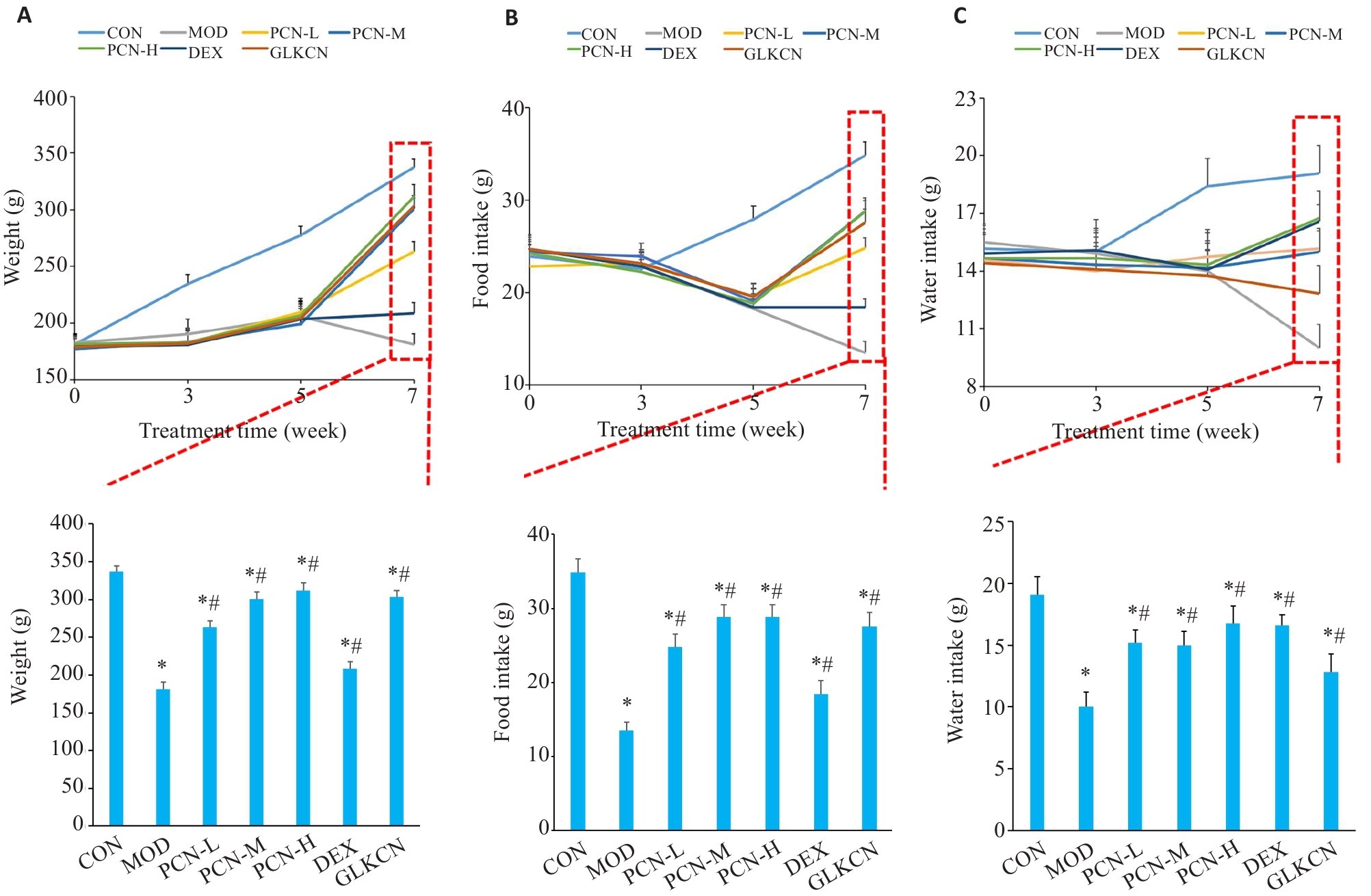
Fig.2 Comparison of body mass (A), food intake (B), and water intake (C) of the rats among the groups. *P<0.05 vs control group, #P<0.05 vs model group.

Fig.4 Lung histopathology and inflammation scores of the rats in each group (HE staining, scale bar=40 μm). *P<0.05 vs control group, #P<0.05 vs model group (n=6).
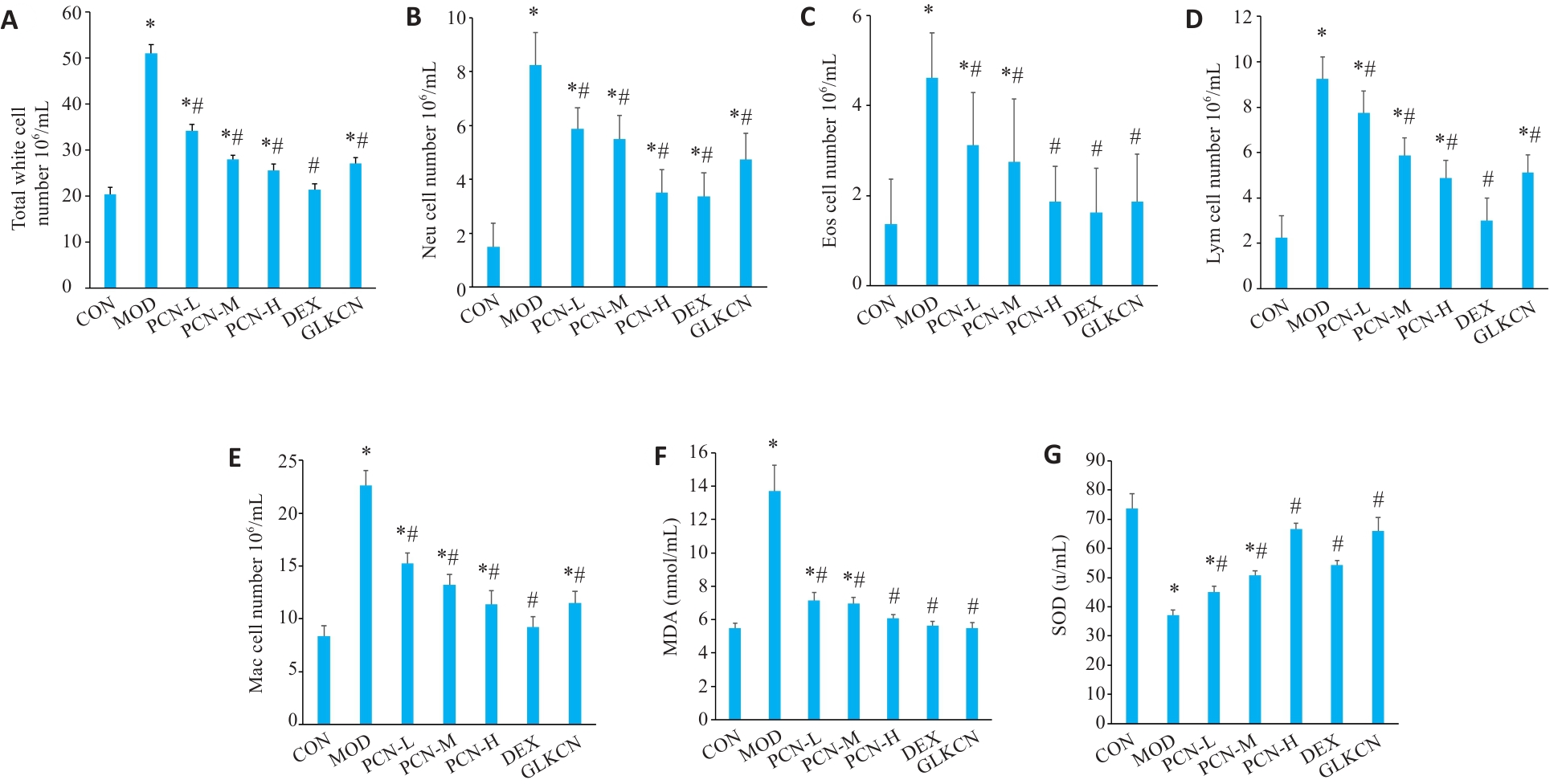
Fig.5 Comparison of inflammatory cell counts in the BALF and oxidative stress factors among the groups. A: Total white cell counts. B: Neu cell counts. C: Eos cell counts. D: Lym cell counts. E: Mac cell counts. F: MDA level. G: SOD level. *P<0.05 vs control group, #P<0.05 vs model group
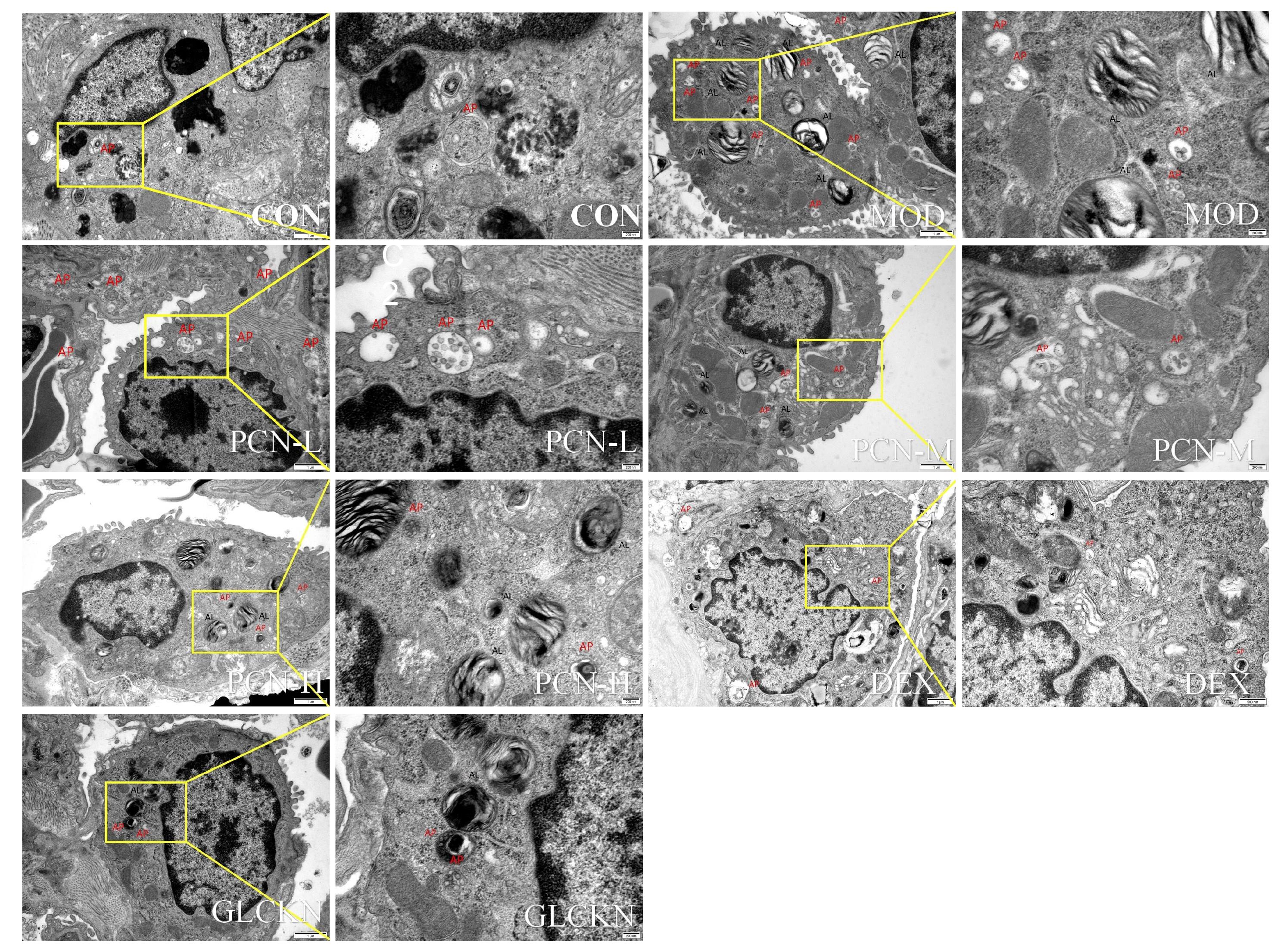
Fig.6 Ultrastructure of lung tissue of rats in each group observed by TEM (Original magnification:×10 000, ×25 000). AP: Autophagosome; AL: Autophagolysosome.
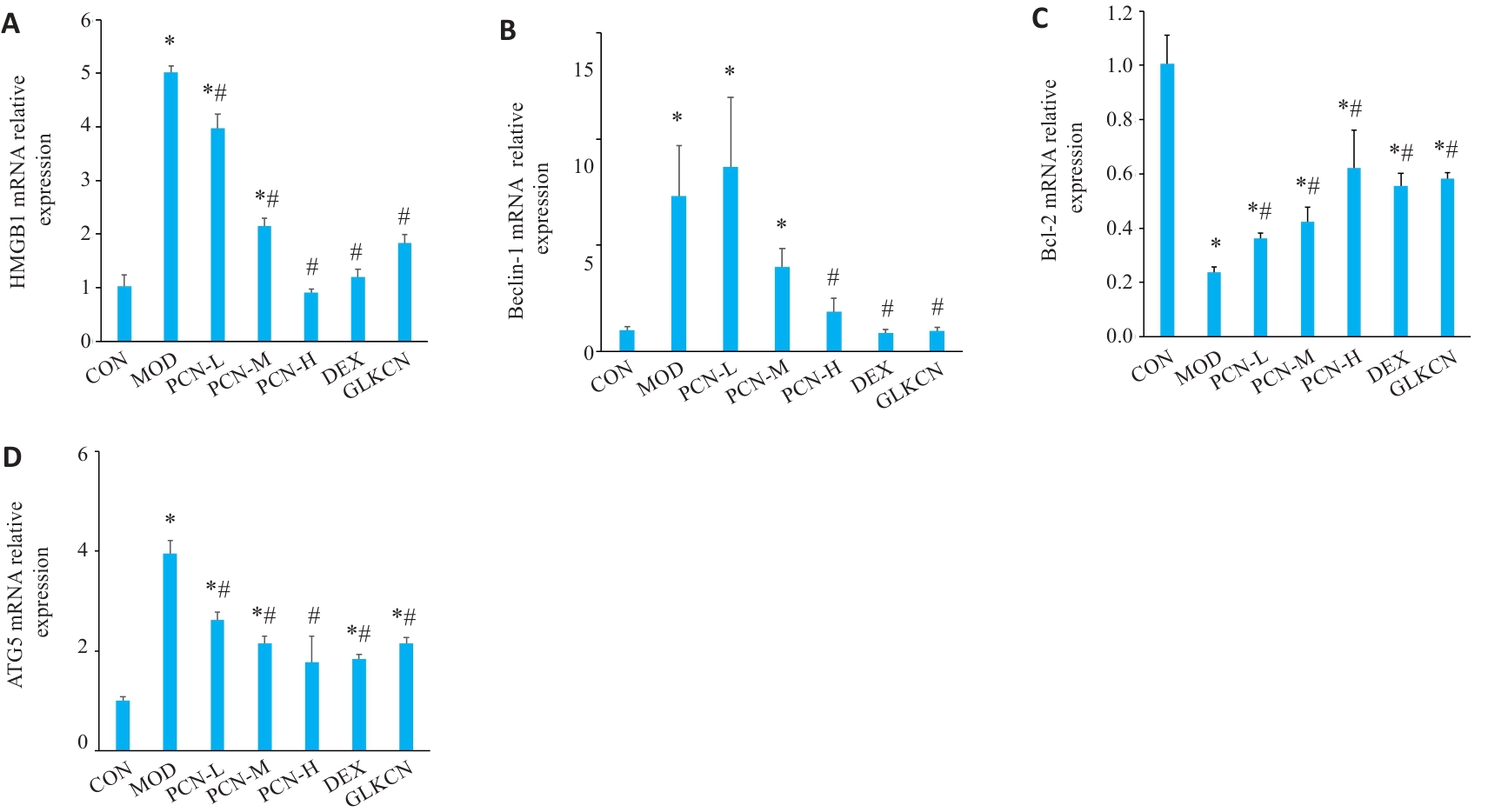
Fig.7 Expression of autophagy-related mRNAs in the lung tissue of the rats in each group. A: HMGB1 mRNA expression; B: Beclin-1 mRNA expression; C: Bcl-2 mRNA expression; D: ATG5 mRNA expression. *P<0.05 vs control group; #P<0.05 vs model group.
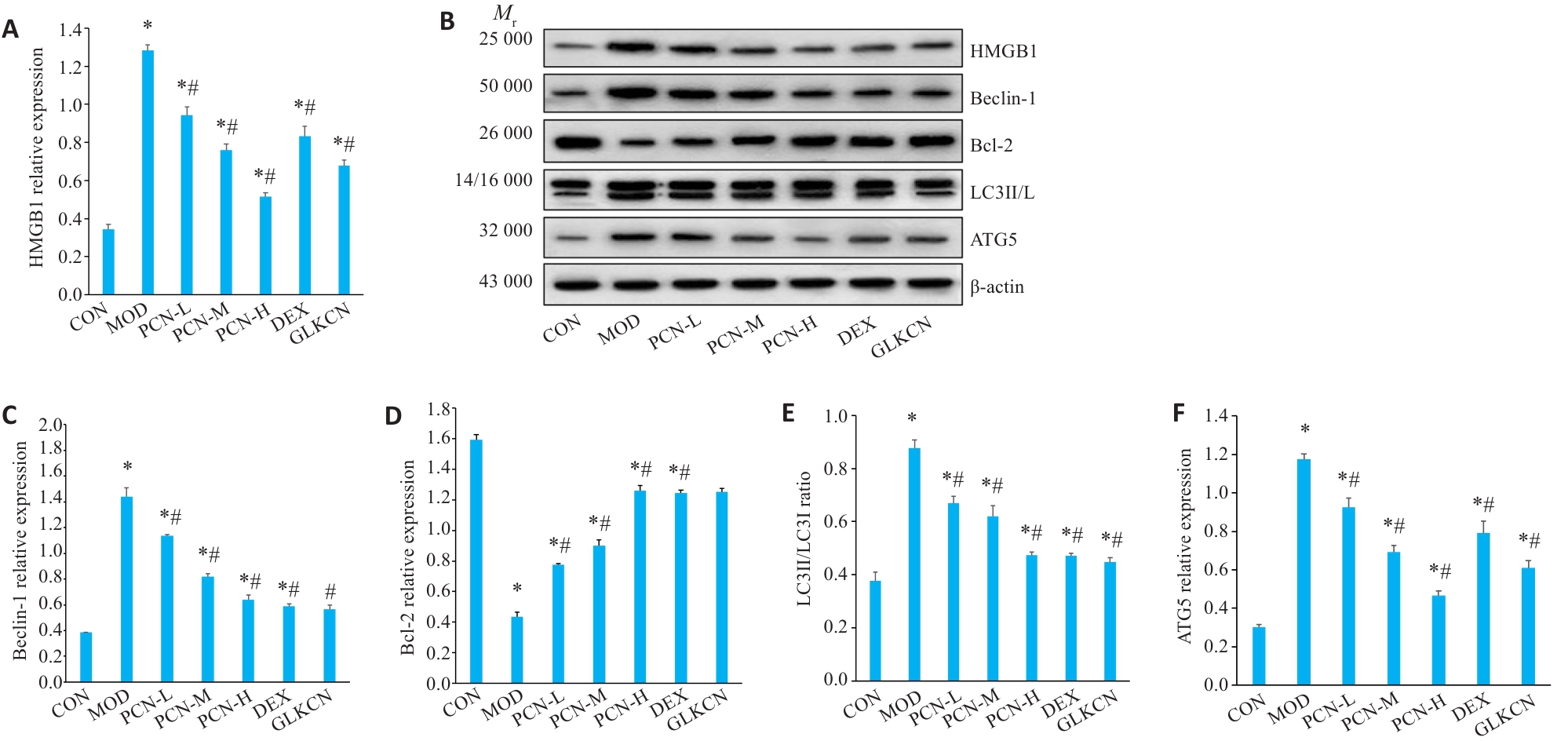
Fig.8 Expression levels of autophagy-associated proteins in the lung tissue of the rats in the groups. A: HMGB1 expression; B: Western blotting for analyzing HMGB1, Beclin-1, Bcl-2, LC3II/LC3I, and ATG5 expressions in the lung tissue; C: Beclin-1 expression; D: Bcl-2 expression; E: LC3II/LC3I ratio; F: ATG5 expression. *P<0.05 vs control group; #P<0.05 vs model group.
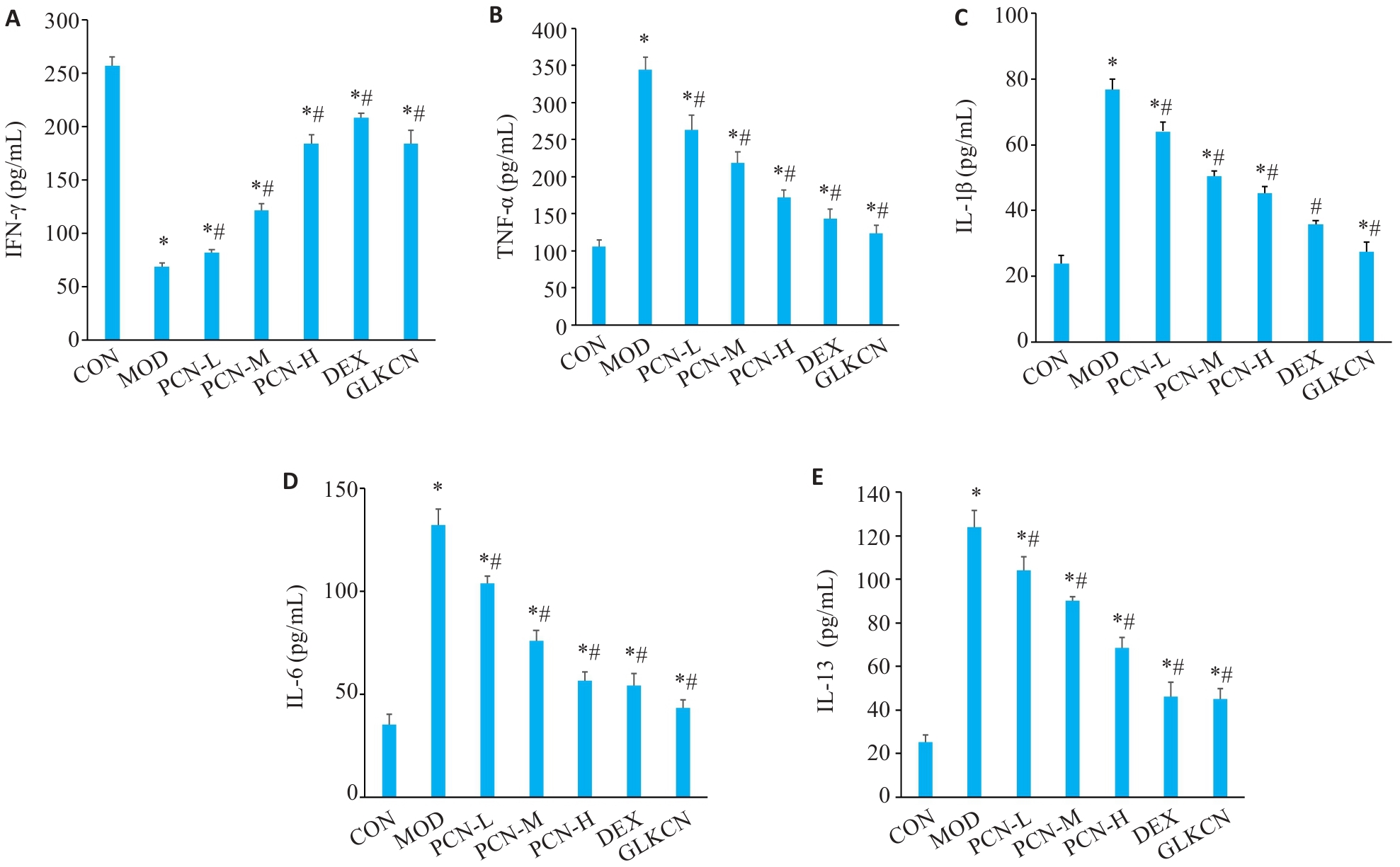
Fig.9 Comparison of lung tissue inflammatory factors among the group. A: IFN-γ expression; B: TNF-α expression; C: IL-1β expression; D: IL-6 expression; E: IL-13 expression. *P<0.05 vs control group; #P<0.05 vs model group (n=8)
| 1 | Qin ZW, Chen YJ, Wang Y, et al. Immunometabolism in the pathogenesis of asthma[J]. Immunology, 2024, 171(1): 1-17. doi:10.1111/imm.13688 |
| 2 | Brasier AR. Innate immunity, epithelial plasticity, and remodeling in asthma[J]. Adv Exp Med Biol, 2023, 1426: 265-85. doi:10.1007/978-3-031-32259-4_13 |
| 3 | Global lnitiative for Asthma.Global strategy for asthma management and prevention[EB/OL].Revised, 2024. |
| 4 | Heffler E, Madeira LNG, Ferrando M, et al. Inhaled corticosteroids safety and adverse effects in patients with asthma[J]. J Allergy Clin Immunol Pract, 2018, 6(3): 776-81. doi:10.1016/j.jaip.2018.01.025 |
| 5 | 范晓璇, 颜培正, 张庆祥. 黄芪甲苷通过LC3/Beclin 1干预哮喘寒饮蕴肺证大鼠细胞自噬的机制[J]. 中华中医药杂志, 2024, 39(11): 6037-42. |
| 6 | Bao WP, Zhang YY, Hang JQ, et al. Short-acting beta-2 agonist prescription patterns and clinical outcomes in Chinese patients with asthma: an observational study in mainland China for the SABINA programme[J]. Ther Adv Respir Dis, 2022, 16: 17534666221115054. doi:10.1177/17534666221115054/v1/review2 |
| 7 | Haughney J, Winders T, Holmes S, et al. A charter to fundamentally change the role of oral corticosteroids in the management of asthma[J]. Adv Ther, 2023, 40(6): 2577-94. doi:10.1007/s12325-023-02479-0 |
| 8 | Sachdeva K, Do DC, Zhang Y, et al. Environmental exposures and asthma development: autophagy, mitophagy, and cellular senescence[J]. Front Immunol, 2019, 10: 2787. doi:10.3389/fimmu.2019.02787 |
| 9 | Dong HN, Yang W, Li W, et al. New insights into autophagy in inflammatory subtypes of asthma[J]. Front Immunol, 2023, 14: 1156086. doi:10.3389/fimmu.2023.1156086 |
| 10 | Wen X, Yang Y, Klionsky DJ. Moments in autophagy and disease: past and present[J]. Mol Aspects Med, 2021, 82: 100966. doi:10.1016/j.mam.2021.100966 |
| 11 | Debeuf N, Lambrecht BN. Eicosanoid control over antigen presenting cells in asthma[J]. Front Immunol, 2018, 9: 2006. doi:10.3389/fimmu.2018.02006 |
| 12 | Li BB, Chen YL, Pang FZ. microRNA-30a targets ATG5 and attenuates airway fibrosis in asthma by suppressing autophagy[J]. Inflammation, 2020, 43(1): 44-53. doi:10.1007/s10753-019-01076-0 |
| 13 | Cao XM, Wang K, Zhu HZ. Yanghepingchuan granule improves airway inflammation by inhibiting autophagy via miRNA328-3p/high mobility group box 1/Toll-like receptor 4 targeting of the pathway of signaling in rat models of asthma[J]. J Thorac Dis, 2023, 15(11): 6251-64. doi:10.21037/jtd-23-1262 |
| 14 | Tao ZP, Helms MN, Leach BCB, et al. Molecular insights into the multifaceted functions and therapeutic targeting of high mobility group box 1 in metabolic diseases[J]. J Cell Mol Med, 2022, 26(14): 3809-15. doi:10.1111/jcmm.17448 |
| 15 | Zhang D, Zhang JT, Xu CJ, et al. A humanized mouse model to study asthmatic airway remodeling and Muc-5ac secretion via the human IL-33[J]. Allergy, 2024, 79(5): 1364-7. doi:10.1111/all.16030 |
| 16 | Quan JY, Wen XX, Su GM, et al. Epithelial SIRT6 governs IL-17A pathogenicity and drives allergic airway inflammation and remodeling[J]. Nat Commun, 2023, 14(1): 8525. doi:10.1038/s41467-023-44179-x |
| 17 | Qu LH, Chen C, Chen YY, et al. High-mobility group box 1 (HMGB1) and autophagy in acute lung injury (ALI): a review[J]. Med Sci Monit, 2019, 25: 1828-37. doi:10.12659/msm.912867 |
| 18 | Yang QN, Li M, Hou YJ, et al. High-mobility group box 1 emerges as a therapeutic target for asthma[J]. Immun Inflamm Dis, 2023, 11(12): e1124. doi:10.1002/iid3.1124 |
| 19 | Chen YJ, Shimizu Bassi G, Wang Y, et al. Research hotspot and frontier analysis of traditional Chinese medicine in asthma using bibliometric methods from 1991 to 2021[J]. J Allergy Clin Immunol Glob, 2022, 1(4): 185-97. doi:10.1016/j.jacig.2022.07.004 |
| 20 | 方向明, 孙子凯. 平喘宁对哮喘患者血清嗜酸细胞阳离子蛋白及白细胞介素2受体的影响[J]. 中国中医药科技, 2002, 9(3): 160. doi:10.3969/j.issn.1005-7072.2002.03.038 |
| 21 | 方向明, 王德均. 平喘宁对哮喘患者白细胞流变特性CD18 +表达及SICAM-1水平的影响[J]. 辽宁中医杂志, 2001, 28(12): 732. doi:10.3969/j.issn.1000-1719.2001.12.016 |
| 22 | 杨勤军, 王 卉, 徐淑钰, 等. 参芪调肾方减轻慢阻肺肺肾气虚证大鼠气道炎症的机制: 基于铁死亡途径[J]. 南方医科大学学报, 2024, 44(10): 1937-46. doi:10.12122/j.issn.1673-4254.2024.10.12 |
| 23 | 杨勤军. 麻芍平喘汤治疗支气管哮喘(冷哮证)临床疗效观察及实验研究[D]. 合肥: 安徽中医药大学, 2020. |
| 24 | Ridzuan N, Zakaria N, Widera D, et al. Human umbilical cord mesenchymal stem cell-derived extracellular vesicles ameliorate airway inflammation in a rat model of chronic obstructive pulmonary disease (COPD)[J]. Stem Cell Res Ther, 2021, 12(1): 54. doi:10.1186/s13287-020-02088-6 |
| 25 | 蔡 旻, 方向明. 平喘宁调节PI3K信号通路干预寒哮大鼠肺组织气道炎症机制[J]. 辽宁中医药大学学报, 2024, 26(5): 19-24. doi:10.13194/j.issn.1673-842x.2024.05.004 |
| 26 | 陈林林, 谢金根, 樊学程, 等. 麻黄与杏仁配伍后在支气管哮喘模型大鼠体内的药动学研究[J]. 中国药房, 2024, 35(13): 1588-93. doi:10.6039/j.issn.1001-0408.2024.13.08 |
| 27 | 马继兴. 神农本草经辑注[M]. 北京: 人民卫生出版社, 1995: 74, 96, 201, 335, 398. |
| 28 | 周亚丽, 杨 萍, 李喜香, 等. 半夏化学成分与药理作用研究进展及其质量标志物(Q-Marker)预测[J]. 中草药, 2024, 55(14): 4939-52. doi:10.7501/j.issn.0253-2670.2024.14.029 |
| 29 | 金 鑫, 李春楠, 张 辉. 贝母属药材中生物碱类化学成分及其药理活性研究进展[J]. 中药材, 2022, 45(9): 2273-9. doi:10.13863/j.issn1001-4454.2022.09.044 |
| 30 | 李思维, 郝二伟, 杜正彩, 等. 广地龙化学成分和药理作用的研究进展及其质量标志物(Q-Marker)的预测分析[J]. 中草药, 2022, 53(8): 2560-71. doi:10.7501/j.issn.0253-2670.2022.08.033 |
| 31 | 王 为, 潘赐明, 胡 倩, 等. 基于网络药理学研究半夏-陈皮-茯苓角药治疗胃癌的分子生物学机制[J]. 实用中医内科杂志, 2023, 37(8): 39-42, 181-2. |
| 32 | Ying Y, Sun CB, Zhang SQ, et al. Induction of autophagy via the TLR4/NF-κB signaling pathway by astragaloside Ⅳ contributes to the amelioration of inflammation in RAW264.7 cells[J]. Biomed Pharmacother, 2021, 137: 111271. doi:10.1016/j.biopha.2021.111271 |
| 33 | Hyrkäs-Palmu H, Jaakkola MS, Mäkikyrö EMS, et al. Subtypes of asthma and cold weather-related respiratory symptoms[J]. Int J Environ Res Public Health, 2022, 19(14): 8790. doi:10.3390/ijerph19148790 |
| 34 | Michaeloudes C, Abubakar-Waziri H, Lakhdar R, et al. Molecular mechanisms of oxidative stress in asthma[J]. Mol Aspects Med, 2022, 85: 101026. doi:10.1016/j.mam.2021.101026 |
| 35 | Ong G, Logue SE. Unfolding the interactions between endoplasmic reticulum stress and oxidative stress[J]. Antioxidants, 2023, 12(5): 981. doi:10.3390/antiox12050981 |
| 36 | Rahman I, Morrison D, Donaldson K, et al. Systemic oxidative stress in asthma, COPD, and smokers[J]. Am J Respir Crit Care Med, 1996, 154(4 Pt 1): 1055-60. doi:10.1164/ajrccm.154.4.8887607 |
| 37 | Mizushima N, Levine B. Autophagy in human diseases[J]. N Engl J Med, 2020, 383(16): 1564-76. doi:10.1056/nejmra2022774 |
| 38 | Jiang L, Diaz PT, Best TM, et al. Molecular characterization of redox mechanisms in allergic asthma[J]. Ann Allergy Asthma Immunol, 2014, 113(2): 137-42. doi:10.1016/j.anai.2014.05.030 |
| 39 | Frisardi V, Matrone C, Street ME. Metabolic syndrome and autophagy: focus on HMGB1 protein[J]. Front Cell Dev Biol, 2021, 9: 654913. doi:10.3389/fcell.2021.654913 |
| 40 | Tang DL, Kang R, Zeh HJ, et al. The multifunctional protein HMGB1: 50 years of discovery[J]. Nat Rev Immunol, 2023, 23(12): 824-41. doi:10.1038/s41577-023-00894-6 |
| 41 | Xu SL, Liu WH, Zhang LC, et al. High mobility group box 1 levels as potential predictors of asthma severity[J]. Chin Med J, 2023, 136(13): 1606-8. doi:10.1097/cm9.0000000000002491 |
| 42 | Rong YL, Fan J, Ji CY, et al. USP11 regulates autophagy-dependent ferroptosis after spinal cord ischemia-reperfusion injury by deubiquitinating Beclin 1[J]. Cell Death Differ, 2022, 29(6): 1164-75. doi:10.1038/s41418-021-00907-8 |
| 43 | Wu WL, Gao JL, Chen D, et al. Epithelial microRNA-30a-3p targets RUNX2/HMGB1 axis to suppress airway eosinophilic inflammation in asthma[J]. Respir Res, 2022, 23(1): 17. doi:10.1186/s12931-022-01933-x |
| 44 | Zeng XN, Liu FW, Liu KY, et al. HMGB1 could restrict 1, 3-β-glucan induced mice lung inflammation by affecting Beclin1 and Bcl2 interaction and promoting the autophagy of epithelial cells[J]. Ecotoxicol Environ Saf, 2021, 222: 112460. doi:10.1016/j.ecoenv.2021.112460 |
| 45 | Zhu Q, Song JX, Chen JY, et al. Corynoxine B targets at HMGB1/2 to enhance autophagy for α-synuclein clearance in fly and rodent models of Parkinson's disease[J]. Acta Pharm Sin B, 2023, 13(6): 2701-14. doi:10.1016/j.apsb.2023.03.011 |
| 46 | Meng QY, Pu LY, Qi MR, et al. Laminar shear stress inhibits inflammation by activating autophagy in human aortic endothelial cells through HMGB1 nuclear translocation[J]. Commun Biol, 2022, 5(1): 425. doi:10.1038/s42003-022-03392-y |
| [1] | Qinjun YANG, Hui WANG, Shuyu XU, Cheng YANG, Huanzhang DING, Di WU, Jie ZHU, Jiabing TONG, Zegeng LI. Shenqi Tiaoshen Formula alleviates airway inflammation in rats with chronic obstructive pulmonary disease and kidney qi deficiency syndrome by inhibiting ferroptosis via regulating the Nrf2/SLC7A11/GPX4 signaling pathway [J]. Journal of Southern Medical University, 2024, 44(10): 1937-1946. |
| [2] | XU Chen, LI Chunying, WANG Sheng. Yifei Jianpi recipe improves cigarette smoke-induced inflammatory injury and mucus hypersecretion in human bronchial epithelial cells by inhibiting the TLR4/NF-κB signaling pathway [J]. Journal of Southern Medical University, 2023, 43(4): 507-515. |
| [3] | YE Yanmei, HU Dapeng, HUANG Shuyu, ZHAO Wenqu, LIANG Jianpeng, HUANG Junwen, HAN Huishan, YANG Shuluan, CAI Shaoxi, ZHAO Haijin. History of atopy reduces predictive value of fractional exhaled nitric oxide for eosinophilic airway inflammation in chronic cough [J]. Journal of Southern Medical University, 2022, 42(10): 1470-1475. |
| [4] | . Role of mammalian target of rapamycin activation in menthol-induced expressions of airway inflammation-related factors in human bronchial epithelial cells in vitro [J]. Journal of Southern Medical University, 2019, 39(11): 1344-1349. |
| [5] | . Correlation between expressions of myeloperoxidase and eosinophil cationic protein in sputum and clinical features of asthma-chronic obstructive pulmonary disease overlap [J]. Journal of Southern Medical University, 2018, 38(10): 1215-. |
| [6] | . Clinical significance of peripheral blood neutrophil-lymphocyte ratio and plateletlymphocyte ratio in patients with asthma [J]. Journal of Southern Medical University, 2017, 37(01): 84-. |
| [7] | . Inhibitory effect of miR-20b on airway inflammation in asthmatic mice [J]. Journal of Southern Medical University, 2015, 35(10): 1463-. |
| [8] | . Effectiveness and safety of azithromycin in the treatment of bronchial asthma: a metaanalysis [J]. Journal of Southern Medical University, 2015, 35(01): 83-. |
| [9] | . Predictive equations of lung function for adults in north China urban areas [J]. Journal of Southern Medical University, 2013, 33(11): 1590-. |
| [10] | . [J]. Journal of Southern Medical University, 2012, 32(10): 1431-. |
| [11] | ZHANG Wei-zhen1,CAI Shao-xi1,ZOU Fei2,ZHAO Hai-jin1,LI Wen-jun2 Department of Respiratory Diseases,Nanfang Hospital1,College of Public Health and Tropical Medicine2,Southern Medical University,Guangzhou 510515,China. Role of Slingshot-1L in peripheral eosinophils of asthmatic patients [J]. Journal of Southern Medical University, 2006, 26(12): 1698-. |
| [12] | HUANG Shao-dan1,YANG Jun1,ZHANG Shi-ye2,TIAN Li-qi1,PAN Qiao-hong1 1Department of Respiratory Diseases,Second Affiliated Hospital of Guangzhou Medical College,Guangzhou 510260,China;2Department of Respiratory Diseases,Second People’s Hospital of Guangzhou,Guangzhou 510150,China. Clinical efficacy of low-dose oral theophylline for treating mild asthma [J]. Journal of Southern Medical University, 2006, 26(03): 325-327. |
| [13] | ZHAO Hai-jin1, CAI Shao-xi1, ZOU Fei2, TONG Wan-cheng1, WAN Wei-ren2. Super SMART cDNA synthesis technology for amplifying small amount of total RNA of peripheral blood eosinophils from asthma patients [J]. Journal of Southern Medical University, 2004, 24(09): 1037-1039. |
| [14] | XU Jin-song, CAI Shao-xi, ZOU Fei, TONG Wan-cheng, ZHAO Hai-jin. Cloning of differentially expressed genes of eosinophils from asthmatic patients by suppression subtractive hybridization [J]. Journal of Southern Medical University, 2004, 24(05): 509-512. |
| Viewed | ||||||
|
Full text |
|
|||||
|
Abstract |
|
|||||